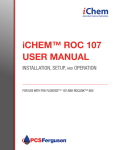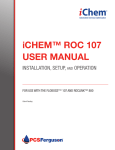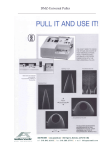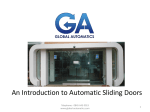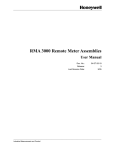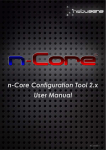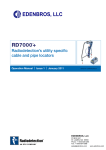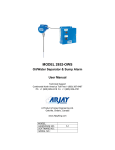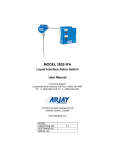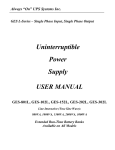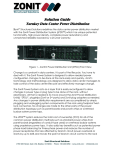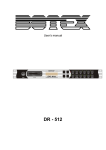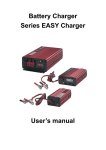Download iChem User Manual
Transcript
www.pcsferguson.com Solar Chemical Injection System Operators Manual Revision #: 6 Revision Date: April 24, 2013 3771 Eureka Way • Frederick, CO 80516 • Phone: 720-407-3550 • Fax: 720-407-3540 © 2012 PCS Ferguson. All rights reserved The PCS Ferguson documents and manuals are Copyright ©2012 by PCS Ferguson. All rights reserved. The iChem Getting Started Guide, Installation and Operation's Manuals are the property of PCS Ferguson and are not intended for public distribution. All trade names or registered trademark names are the property of their respective owners and are referenced only herein without ownership implication. 3771 Eureka Way Frederick, CO 80516 Phone: 720-407-3550 Fax: 720-407-3540 iChem Solar Chemical Injection System – Operators Manual Rev #6 Page 2 of 23 Contents DOCUMENT OVERVIEW .............................................................................................................................................................. 4 CHAPTER 1 INTRODUCTION .................................................................................................................................................... 5 1.1 1.1.1 1.1.2 1.1.3 1.1.4 ICHEM COMPONENTS ....................................................................................................................................................... 5 iChem Pump ................................................................................................................................................................... 5 Frame ............................................................................................................................................................................... 5 Power System................................................................................................................................................................. 5 Auto-Cycle Intelligent Controller .................................................................................................................................. 5 CHAPTER 2 PRE-FABRICATION .............................................................................................................................................. 7 2.1 2.2 2.2.1 2.2.2 2.2.3 2.2.4 2.2.5 A-FRAME ASSEMBLY ........................................................................................................................................................ 7 COMPONENT MOUNTING ................................................................................................................................................ 10 Battery Enclosure Mounting ....................................................................................................................................... 10 Electronic Controller Mounting ................................................................................................................................... 10 Chemical Pump Mounting ........................................................................................................................................... 11 Solar Panel Mounting .................................................................................................................................................. 11 System Wiring............................................................................................................................................................... 12 CHAPTER 3 ON SITE INSTALLATION ....................................................................................................................................13 3.1 3.2 3.3 3.3.1 3.3.2 3.3.3 3.3.4 3.3.5 PLUMBING ....................................................................................................................................................................... 13 PRIMING THE PUMP ........................................................................................................................................................ 14 PERFORMING A CHEMICAL INJECTION RATE TEST ........................................................................................................ 14 Put the controller in Stop mode in the OFF cycle.................................................................................................... 14 Fill the chemical sight glass. ....................................................................................................................................... 14 Input test parameters to iChem controls and set pump cycle times. .................................................................... 14 Reopen the chemical line and turn the pump on. .................................................................................................... 15 Dual Pump Mode (provided a feature key is purchased) ....................................................................................... 15 CHAPTER 4 ICHEM CONTROLS ..............................................................................................................................................16 4.1 4.2 4.3 4.4 4.4.1 4.4.2 4.4.3 ACTIVATE RUN/STOP MODE ...................................................................................................................................... 16 CHECK BATTERY CHARGE ............................................................................................................................................. 16 SET UP PUMP OPERATION PARAMETERS ..................................................................................................................... 17 CALIBRATE TRANSDUCERS ............................................................................................................................................ 17 Calibrate Injection Pressure ....................................................................................................................................... 17 Calibrate Injection Temperature................................................................................................................................. 18 Calibrate Injection Tank Level .................................................................................................................................... 18 CHAPTER 5 APPENDIX A: CONTROLLER WIRING .............................................................................................................19 5.1 5.2 W IRING DIAGRAM WITH PCB RELAY – NO TRANSDUCERS........................................................................................... 19 MOTOR CONTROLLER SETTINGS ................................................................................................................................... 20 CHAPTER 6 APPENDIX B: TROUBLESHOOTING ................................................................................................................21 CHAPTER 7 APPENDIX C: ICHEM SITE SURVEY ................................................................................................................22 CHAPTER 8 APPENDIX D: AGENCY APPROVAL ................................................................................................................23 iChem Solar Chemical Injection System – Operators Manual Rev #6 Page 3 of 23 Document Overview Chapter 1 Introduction: Provides an overview of the iChem Chemical Injection System, its components and functional capabilities. Chapter 2 Pre-Fabrication: Provides assembly instructions for the iChem system prior to delivering the unit to the well site. Chapter 3 On Site Installation: Provides plumbing diagrams and instructions for performing and injection rate test. Chapter 4 iChem Controls: Provides a functional description of the Keypad/Display Terminal menu. Chapter 5 Appendix A: Controller Wiring: Provides a listing of the factory wiring and settings for the controller box. Chapter 6 Appendix B: Troubleshooting: Provides a table for troubleshooting common problems. Chapter 7 Appendix C: iChem Site Survey: To be filled out prior to installation. Chapter 8 Appendix D: Agency Approval: Provides CSA ratings and warnings. iChem Solar Chemical Injection System – Operators Manual Rev #6 Page 4 of 23 Chapter 1 Introduction Chemical Pump reliability and consistency are of utmost importance to oil and gas producers. Unfortunately, many chemical injection systems do not deliver the desired results. PCS Ferguson offers iChem, an innovative solar-powered chemical injection system with a superior pump design. iChem delivers consistent, accurate injection rates for wells up to 1,200 psi. This advanced system is engineered to meet the needs voiced by our industry: Reduce Field Service and Maintenance Downtime Eliminate Chemical Loss Due to Leaks Precise and Consistent Injection Rates at Various Pressures The Benefits: Decreased Maintenance Protect against Chemical Leaks Reliable Dosing Rates 1.1 iChem Components Neptune Solar Panel Operated Pump PCS Ferguson Auto-Cycle Intelligent Controller Power System A-Frame Assembly 1.1.1 iChem Pump The chemical pump is designed with hydraulically balanced diaphragm technology for durability. Its 316SS and Teflon coated “wet end” is designed to handle a wide variety of chemicals for many applications and the attached brushless motor allows for highly consistent chemical dosing. A separate manual was included in the system packaging for the chemical pump itself. Any issues specifically concerning the chemical pump can be found there. 1.1.2 Frame The A-frame is designed to hold all the components included in the iChem system. The AFrame allows the user to complete most of the prep work (pre-fabrication) in a central office before transporting it to the well site, greatly reducing on-site installation time. It is also easily transportable and foldable if necessary. 1.1.3 Power System The iChem power system typically includes a 12V, 100Ah battery in a lockable enclosure and a 50W or 80W solar panel depending on well site conditions such as injection pressure, daily chemical injection rate, available sunlight in region, and more. Larger power systems can be designed for special needs if necessary. 1.1.4 Auto-Cycle Intelligent Controller The Auto-Cycle Intelligent Controller (ACiC) employs a liquid crystal display (LCD) with keypad interface for highly accurate settings. The controls operate the pump via intermittent ON and OFF phases that can be defined down to the second to inject the exact amount of chemical the well needs. To aid in quickly and accurately setting the ON and OFF cycle times to inject chemical at the desired rate, an on-board calculation routine is included in the control software to be used when performing a typical rate test (refer to section !). The controller also provides system data such as iChem Solar Chemical Injection System – Operators Manual Rev #6 Page 5 of 23 battery voltage, casing pressure (if pressure transducer is installed), and more to monitor the well site and ensure the iChem system is working properly. The system comes with the optional feature of remotely monitoring the system data and controlling pump control settings with an add-on. iChem Solar Chemical Injection System – Operators Manual Rev #6 Page 6 of 23 Chapter 2 Pre-Fabrication Prior to delivering the system to the well site for installation, it is recommended that prefabrication assembly occur in a sheltered central office or location. The system can then be transported via truck to the installation site where the final installation steps can be performed. The pre-fabrication assembly work includes assembling the A-frame, mounting the system components, and gathering the tools and equipment needed for installation. 2.1 A-Frame Assembly The A-frame components will arrive disassembled with the pieces illustrated in Figure 2.1 and Error! Reference source not found.. ① ⑥ ⑤ ② No. Component Qty Primary Frame Support 1 Frame Platform 1 Secondary Frame 2 Support ④ Controller Stem 1 ⑤ Solar Panel Extender 2 ⑥ Solar Panel Bracket 4 ⑦ Bolt Kit (not pictured) 1 Table 2.1: A-Frame Component List ① ② ③ ④ ③ Figure 2.1: A-Frame Component Identification 1. 2. 3. Hold the Primary Frame Support ① upright so that the foot pads rest flat on the ground. Slide the Secondary Frame Supports ③ into the slot at the top of the Primary Frame Support so that the securing holes line up as shown in Figure 2.2. Secure each support with (1) ¼”x2½” bolt, (2) ¼” spacers, and (1) ¼” hex nut. Do not tighten. ! Do not tighten any of the bolts until Step 7. iChem Solar Chemical Injection System – Operators Manual Rev #6 Page 7 of 23 ① ③ Figure 2.2: A-Frame Support Assembly 4. Position the Frame Platform ② between the Primary Frame Support ① with the flat surface facing up as shown in Figure 2.3. 5. Secure each side of the Frame Platform ② to the lower mounting holes on the Primary Frame Support ① using (1) ¼”x2½” bolt, (2) ¼” spacers, and (1) ¼” hex nut. Do not tighten. ① ② Figure 2.3: Frame Platform Assembly 6. Swivel the Frame Platform ② up between the Secondary Frame Supports ③ and secure each support to the platform using (1) ¼”x2½” bolt, (2) ¼” spacers, and (1) ¼” hex nut. 7. Tighten all 6 bolts ensuring that the foot pads rest evenly on the ground as shown in Figure 2.4. 8. Attach the outer most of the 5 adjustment holes on the Solar Panel Extenders ⑤ to the upper mounting holes on the Secondary Frame Support ③ as shown in Figure 2.5 using (2) 5/16”x3/4” bolts, (2) 5/16”. ③ ③ Figure 2.4: Completed Platform Adjustment Holes ⑤ ⑤ Figure 2.5: Solar Panel Extenders 9. Attach a Solar Panel Bracket ⑥ to each of the Solar Panel Extenders ⑤ mounting holes as shown in Figure 2.6 using (1) ¼”x¾” bolt and (1) ¼” hex nut. Do not tighten. ⑤ ⑥ iChem Solar Chemical Injection System – Operators Manual Rev #6 Page 8 of 23 Figure 2.6: Solar Panel Extended Brackets 10. Attach (2) Solar Panel Brackets ⑥ to each side of the top of the Primary Frame Support ① mounting holes as shown in Figure 2.8 using (1) ¼”x¾” bolt and (1) ¼” hex nut. Do not tighten. ⑥ ① ⑥ Figure 2.8: Solar Panel Brackets 11. Mount the Controller Stem ④ to the flat side of the cross brace on the Primary Frame Support ① as shown in Figure 2.7 using (2) 5/16”x3/4” bolts, (2) 5/16” spacers, (2) 5/16” lock washers, and (2) 5/16” hex nuts. 12. The A-Frame Assembly should now be similar to the frame shown in Figure 2.9. ④ ① Figure 2.7: Controller Stem Assembly Figure 2.9: Completed A-Frame Assembly iChem Solar Chemical Injection System – Operators Manual Rev #6 Page 9 of 23 2.2 Component Mounting Once the frame is constructed, the system components can then be mounted to it. These components include the solar panel, battery with enclosure, control box, and chemical pump. Other components or different quantities may be included for special install packages. 2.2.1 Battery Enclosure Mounting 1. Place the empty Battery enclosure on the A-Frame Platform as shown in Figure 2.10. Position the cord grip insertion holes facing inward toward the center of the frame. 2. Bolt down only 2 opposite corners of the enclosure using (2) ¼”x¾” bolts, (2) ¼” washers, (2) ¼” fender washers, (2) ¼” lock washers, and two (2) ¼” hex nuts. 2.2.2 Electronic Controller Mounting The control box has a conduit fitting on the underside, a separate PVC flex conduit, and wires curled up inside the box. There will be two (2) sets of curled wires of four (4) foot length. One set contains five (5) wires while the other contains three (3). Figure 2.10: Battery Enclosure Mounting 1. Feed both sets of wires together through the conduit fitting and through the PVC flex conduit as shown in Figure 2.11. 2. Attach the controller enclosure to the controller stem using (4) ¼” x ¾” bolts and (4) ¼” lock washers. ! Ensure the bolts connecting the control stem are tight. Figure 2.11: Electronic Controller Box The controller may be hoisted to the controller stem or the stem may be removed and reattached after attaching the controller. iChem Solar Chemical Injection System – Operators Manual Rev #6 Page 10 of 23 2.2.3 Chemical Pump Mounting 1. Mount the conduit fitting from the electronic controller to the junction box on the chemical pump and feed the wires through. Figure 2.12: Chemical Pump Conduit Fitting 2. The junction box contains two (2) wire connectors, one a set of five (5) and the other of three (3). Using a small flathead screw driver, connect each free wire from the control box to the corresponding wire in the wire connector in the junction box. Press these back into the junction box and close the lid securely. ! Ensure the connecting wires are the same color and size. 3. Place the chemical pump on the frame platform. Orient it as needed depending on the position of the chemical tank or the layout of the site. ! Figure 2.13: Chemical Pump Wiring Ensure sure the two check valves on the front 316SS diaphragm head extend beyond the edge of the base. When positioned correctly, the front two holes on the pump stand will not be able to be bolted to the frame platform. 4. Use (2) ¼” x ¾” bolts, (2) ¼” washers, (2) ¼” fender washers, (2) ¼” lock washers, and (2) ¼” hex nuts to secure the (2) rear pump stand holes to the frame platform. 2.2.4 If the pump must be within the containment pool, the length of conduit should allow the pump to reach comfortably with the frame positioned beside the pool. The control box stem can be repositioned to the edge of the Primary Frame Support to allow greater reach. Figure 2.14: Chemical Pump Mounting Solar Panel Mounting 1. Mount the solar panel to the Solar Panel Brackets using (4) ¼”x¾” hex head bolts, (4) ¼” washers, and (4) ¼” hex nuts. If desired, the L-brackets may be mounted to the solar panel first before mounting to the frame. iChem Solar Chemical Injection System – Operators Manual Rev #6 Page 11 of 23 2.2.5 System Wiring Once the components are mounted, they can then be interconnected. 2. Feed the battery wires from the charge regulator in the battery box up to the control box. 3. Inside the control box will be a black motor controller as shown below. Connect the white battery wire to share the connection labeled V IN with relay and the black battery wire to the connection labeled GND. 4. Feed the solar panel wires to the battery box and connect to the solar charge regulator inside. 5. Connect the battery to the charge regulator and place inside the battery box. Figure 2.15: Controller Wiring iChem Solar Chemical Injection System – Operators Manual Rev #6 Page 12 of 23 Chapter 3 On Site Installation 3.1 Plumbing LEGEND ③ Chemical Flow Direction Ball Valve Check Valve ② Pressure Gauge (PSI) ⑦ ⑤ ⑥ ④ ① Casing Line Figure 3.1: Chemical Injection Pump Plumbing Diagram No. Component ① iChem Pump ② Chemical Tank ③ Chemical Sight Glass ④ Injection Point (Y-Check Valve) ⑤ Tank Valve ⑥ Sight Glass Valve ⑦ Well Head Table 3.2: Chemical Injection Pump Component Identification ! Installing a latch valve inside any portion of the iChem enclosures is prohibited. Use only Class 1 Division 2 remote latch valves such as PCS Ferguson part number: VA00A10 iChem Solar Chemical Injection System – Operators Manual Rev #6 Page 13 of 23 3.2 Priming the Pump ALWAYS prime the pump when first installing a pump on a new location to purge the air out of the pump and prevent future problems. Even though the pump may function at low or zero pressure, the pump must be primed. Priming removes air pockets from the oil side of the pump. Failure to remove all air pockets will result in pumping problems (inefficiency or no pumping) at higher pressures. All air pockets on the oil side MUST be removed. This is also the main technique used to increase the injection rate of a new install if the pump is injecting lower than its rated volume. After the pump is fully installed on location and filled with oil to fill line, remove the 1/8” hex plug from the diaphragm head, just behind the top check valve. Turn the pump on and let the oil pulse out of the bleed port for 5 seconds. Turn off the pump,re-Teflon and replace the 1/8” hex plug. Thoroughly clean the oil from the diaphragm head and from around the hex plug. Turn the pump on and inspect the hex plug for any slight leaks. Tighten if necessary. 3.3 Performing a Chemical Injection Rate Test Performing an injection rate test is necessary to set the pump cycle times correctly. The test should be performed: Following installation After relocating a pump to a new well head Changing injection chemicals After adjusting or replacing any components on the pump or plumbing system. It can only be performed after the iChem system is fully installed and powered up, and the injection line is primed. Refer to Figure 3.1 to follow the parts and numbers used in the instructions below. 3.3.1 Put the controller in Stop mode in the OFF cycle. 1. To ensure controls are set to Stop mode, on the main menu press the SYS (F3) key. Navigate to CONTROL OPTIONS and set CONTROL MODE to STOP. 2. From the main menu, press the SYS (F3) key, select CONTROL MODE, and scroll to PMP 1 CTL MD. Press ENTER. Select STOP and press enter. 3.3.2 Fill the chemical sight glass. 3. With the pump off, close the sight glass valve ⑥ and open the tank valve ⑤. 4. Slowly open the sight glass valve ⑥ and let the chemical rise to the highest visible notch on the sight glass ③. 5. Immediately close the sight glass valve ⑥. Do not fill above this notch. 6. Visibly mark the notch so as to not forget it. 7. With the sight glass valve ⑥ closed, fully close the tank valve ⑤. 8. Open the sight glass valve ⑥ to allow the pump to only pull chemical from the sight glass and not the chemical tank. 3.3.3 Input test parameters to iChem controls and set pump cycle times. 9. On the main menu of the iChem controller, press the SYS (F3) key, select CONTROL MODE, scroll down to SET UP PUMP 1 and press enter. 10. Scroll down to PMP 1 CAL CYC/DAY and press enter. 11. Set PUMP TEST MODE to YES to put the pump in an indefinite Off cycle until it is time to perform a rate test. iChem Solar Chemical Injection System – Operators Manual Rev #6 Page 14 of 23 12. Set TEST TIME for the amount of time the pump will run in the rate test. ! For highest accuracy it is best to set a time long enough to allow the pump to drain most of the chemical from the sight glass, without completely emptying the sight glass. Set TEST TIME to 10s if you are unsure. For larger sight glasses, do not exceed 60s. 13. Scroll down to and set P1 TEST ON to YES. This will cause the pump to cycle on for the amount of time specified in TEST TIME. The chemical in the sight glass ③ should begin dropping. 14. When the pump ① turns off, visibly mark the new level of the chemical in the sight glass ③. 15. Count the number of notches between the two marked notches and record that number in P1 TICS DRP on the controller. If the chemical drains completely out of the sight glass ③, stop the test, refill the sight glass ③, and decrease the TEST LENGTH before restarting the test. 16. Set the sight glass graduation (Qt. per Day or Gal per Hr. based on a one minute test) as labeled on the sight glass ③ in the controller’s P1 GLS GRAD setting. 17. Input the desired injection rate into P1 INJ RATE. 18. Set the units of your desired injection rate in P1 INJ UNITS. For example, to set the chemical pump to inject five gallons per day, set P1 INJ RATE to 5 and P1 INJ UNITS to Gal/Day. 19. Set the number of times the pump will cycle each 24 hour period in P1 CYC/DAY. CYCLES DAY of 0001 will inject the chemical in one large batch each day. CYCLES DAY of 9999 will inject the chemical in numerous small doses spread evenly throughout the day. 20. 21. 22. 23. 3.3.4 Return P1 TEST MODE back to NO. Press the MENU/ESC button on the keypad to return to the previous screen. Scroll to SAVE PMP 1 CYC TIMES and press ENTER on the keypad. Return CONTROL MODE to RUN. Reopen the chemical line and turn the pump on. 24. Close the sight glass valve ⑥ and open the tank valve ⑤ to allow chemical flow only from the chemical tank ② to the pump ①. 25. The pump is now ready to begin injecting chemicals. Press the ON button on the keypad to start the cycle and begin pumping. 3.3.5 Dual Pump Mode (provided a feature key is purchased) 26. Select the second pump by scrolling down to the second pump and pressing enter. Use the same procedures as Pump 1 to calibrate Pump 2. iChem Solar Chemical Injection System – Operators Manual Rev #6 Page 15 of 23 Chapter 4 iChem Controls 4.1 Activate RUN/STOP MODE When the system is first powered on, the controls will boot up in STOP MODE to prevent the pump from inadvertently turning on. In this mode, the ON and OFF buttons on the keypad will not operate the pump(s). In order to perform a rate test and cycle the pump, the controls must be in STOP MODE which can be set from the main menu: CONTROL OPTIONS STUP (F3) CONTROL MODE RUN/STOP Use the arrow keys to navigate and press ENTER to enter each option. CONTROL MODE will initially be listed as STOP. With the cursor on CONTROL MODE, press ENTER and use the right arrow key to change from STOP to RUN then press ENTER again. You can now return to the main menu and use RUN features. 4.2 Check Battery Charge To check battery voltage to determine its charge level, simply navigate the following menu path from the main menu: SYST (F3) SYSTEM STATUS BATTERY VOLTS The voltage will be listed there. For a 12V battery, a full charge typically corresponds to read around 13.4V. For dual pumps scroll to the desired pump on the main menu and proceed with the instructions. iChem Solar Chemical Injection System – Operators Manual Rev #6 Page 16 of 23 4.3 Set Up Pump Operation Parameters To perform a rate test to have the controls calculate the necessary On and Off cycle times to inject a desired amount of chemical, refer to 1.2 Performing a Chemical Injection Rate Test. As a reminder, to navigate to the pump setup menu from the main menu: SYST (F3) Control Options SET UP PUMP 1 PMP 1 CAL CYC/DAY Here you can find and change the following parameters/options: P1 TEST MODE: P1 TEST ON: P1 TST TIME: P1 TICS DRP: P1 GLS GRAD: P1 INJ RATE: P1 INJ UNITS: P1 CYC/DAY: Puts the pump in an extended Off cycle until the user either changes it back to NO, or changes PUMP TEST ON to YES. PUMP TEST MODE must be set to YES to perform a rate test and must be changed back to NO before the pump can cycle as desired. While PUMP TEST MODE is YES, PUMP TEST ON will turn the pump on for the amount of time listed in TEST TIME for the purposes of performing a rate test. The amount of time the pump will run during a rate test when PUMP TEST ON is changed to YES. The number of graduation marks that the chemical dropped in the sight glass during a rate test. Glass Graduation sets the calibration method of the sight glass installed on the chemical tanks to Quarts/Day per 1 Minute Test or Gallons/Hour per 1 Minute Test as indicated on the sight glass. The numerical amount of chemical the pump will inject. It must correspond with INJ UNITS as well. Sets the units in which the INJ RATE will be measured INJ UNITS can be set as QT PR DAY, GAL PR DAY, or GAL PR HR. For example, if INJ RATE is set to 4 and INJ UNITS is set to QT PR DAY, the pump will inject 4 quarts per day. This is the number of times the pump will cycle each day based on its abilities. To inject one large dose each day, set to 0001. To inject multiple small doses, set to 9999. 4.4 Calibrate Transducers 4.4.1 Calibrate Injection Pressure SYST (F2) PMP GAUGE READINGS INJ PRESS CALIBRATE CHANNEL 1. Input the calibrated millivolts from the transducer. 2. Input the pressure range into the Eng. Scale. 3. Compare the injection pressure to the output. iChem Solar Chemical Injection System – Operators Manual Rev #6 Page 17 of 23 4.4.2 Calibrate Injection Temperature SYST (F2) PMP GAUGE READINGS IT CALIBRATE CHANNEL 1. Input the calibrated millivolts from the transducer. 2. Input the pressure range into the Eng. Scale. 3. Compare the ambient temperature to the output. If there is a discrepancy, alter the Eng. Scale until they match. 4.4.3 Calibrate Injection Tank Level SYST (F2) PMP GAUGE READINGS ITL CALIBRATE CHANNEL 1. Input the calibrated millivolts from the transducer. 2. Input the pressure range into the Eng. Scale. 3. Empty the site glass. Scroll to LOW PMP INJ PRESS. Scroll to READ SAMPLE and hit ENTER several times to get an average number. 4. Enter the averaged number into the CALIBRATED MV in the LOW PMP INJ PRESS. 5. Fill the site glass. Scroll to HIGH PMP INJ PRESS. Scroll to READ SAMPLE and hit ENTER several times to get an average number. 6. Enter the averaged number into CALIBRATED MV in the HIGH PMP INJ PRESS section. 7. Compare the level of chemical in the tank to the output. iChem Solar Chemical Injection System – Operators Manual Rev #6 Page 18 of 23 Chapter 5 Appendix A: Controller Wiring 5.1 Wiring Diagram with PCB Relay – No Transducers iChem Solar Chemical Injection System – Operators Manual Rev #6 Page 19 of 23 5.2 Motor Controller Settings As with the controller enclosure wiring, the motor controller settings should not need to be altered. However, if the iChem is not performing correctly and troubleshooting suggests the motor controller settings are incorrect, consult the following controller settings to ensure the knobs and dipswitches match up. Dip Switch State (On = Left) 1 O/C Loop Off 2 CL1 Off 3 CL2 On 4 CL3 On State (On = Left) Dip Switch iChem Solar Chemical Injection System – Operators Manual 1 EXT/INT SPD Off 2 FLT LATCH Off 3 RAMP 1 On 4 RAMP 2 On 5 60°/120° On Rev #6 Page 20 of 23 Chapter 6 Appendix B: Troubleshooting Symptom Possible Cause Solution Pump/Controls do not receive power. Rate test routine does not calculate cycle times Control Mode is set to STOP. Refer to section ! to put set the Control Mode to TIMER. Controls have power but pump does not operate. Pump phase Faulty relay stuck in ON Incorrect Wiring Blown Fuse Battery Discharged Incorrect Wiring Battery Discharged Injection pressure too high Motor controller settings incorrect iChem Solar Chemical Injection System – Operators Manual Refer to section 2.2.5 for correct wiring. Replace fuse in the battery enclosure. Check battery level with a Multimeter Charge or replace battery as needed. Refer to section 2.2.5 for correct wiring. Check battery level with a Multimeter Charge or replace battery as needed Ensure injection pressure is less than the pump rating. Replace the controller relay. Rev #6 Page 21 of 23 Chapter 7 Appendix C: iChem Site Survey Company/Customer:_________________________________________________________________ Location:__________________________________________________________________________ Location Name:_____________________________________________________________________ Address Line 1: _____________________________________________________________________ Address Line 2: _____________________________________________________________________ City (Nearest):________________________________ State: ________________________________ GPS coordinates (if available): range and township?________________________________________ Contact Name & Number: _____________________________________________________________ Site Preparation/Site Survey Notes: Determine the injection chemical and obtain MSDS. o Chemical Vendor: _____________________________ Part No: ______________________________ Determine the well injection pressure. High: ________________________Low: ________________________ Determine the make and model of any existing pump on site. _______________________________________ Determine the desired daily injection rate. If the site has an existing pump, determine its set rate prior to disconnecting. ____________________________________________________________________________ List any rusted pipes and fittings at the chemical tank to replace with stainless steel equivalents. ________________________________________________________________________________________ ________________________________________________________________________________________ ________________________________________________________________________________________ Is there an existing sight glass OR is the existing sight glass leaking or damaged (circle one)? Yes / No(damaged) How often does the chemical tank run empty?____________________________________________________ How long does it typically take to get the chemical tank refilled? _____________________________________ Site Survey performed by:_______________________________________ Date________________ iChem Solar Chemical Injection System – Operators Manual Rev #6 Page 22 of 23 Chapter 8 Appendix D: Agency Approval Agency Compliance: Refer to details below regarding hazardous locations certification: Manufactured by: PCS Ferguson - 3771 Eureka Way Frederick, CO 80516 (720) 407-3550 www.pcsferguson.com Electrical Rating 12Vdc, 100ah Ambient temperature rating: -40°C ≤ Ta ≤ 70°C This equipment is suitable for installation in Class I, Division 2, Group C and D hazardous locations or nonhazardous locations only. WARNING - Explosion Hazard. Do not connect or disconnect this equipment unless power has been removed or the area is known to be nonhazardous. WARNING - Explosion Hazard. Substitution of components may impair suitability for Class I, Division 2 hazardous areas. Notes: 1. iChem must be connected to a power source (i.e. solar panel) rated 12V dc nominal, 26V dc maximum, open circuit; 8A nominal, 10.5A maximum short circuit and appropriately certified for the location. Power source is subject to investigation by the Local Authority Having Jurisdiction at the time of the installation. 2. Wiring to or from this equipment, which enters or leaves the system enclosure, must utilize wiring methods suitable for Class I, Division 2 Hazardous Locations as appropriate for the installation. iChem Solar Chemical Injection System – Operators Manual Rev #6 Page 23 of 23























